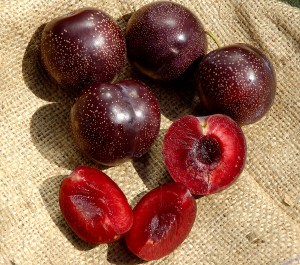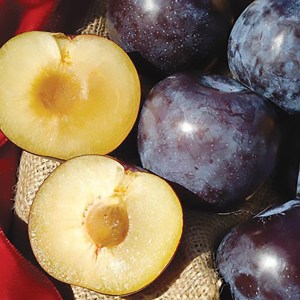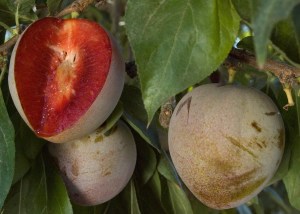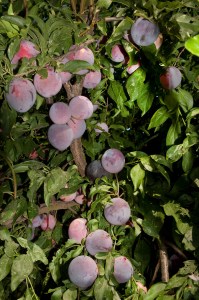Plums & Prunes
Bare Root Plums & Prunes
 The majority of our plum offerings are Japanese varieties, which include many different colors, shapes and flavors. The most familiar and popular is Santa Rosa with its tart purple skin and sweet, juicy, amber flesh. The tree is usually very productive and, if the plums are picked when still firm, they are more useful for cooking and baking. When soft ripe, it is best to eat them out of hand.
The majority of our plum offerings are Japanese varieties, which include many different colors, shapes and flavors. The most familiar and popular is Santa Rosa with its tart purple skin and sweet, juicy, amber flesh. The tree is usually very productive and, if the plums are picked when still firm, they are more useful for cooking and baking. When soft ripe, it is best to eat them out of hand.
Plum trees are usually vigorous growers and they have few diseases in our area, considered to be the dry West. If fungal diseases and insects such as scale occur in your area, a spray of copper sulfate combined with horticultural oil should be applied during the dormant season. When plum leaves start to curl, many people suspect that their trees have been infected with peach leaf curl, the fungal disease of peaches and nectarines. However, curled plum leaves generally indicate the presence of aphids. This problem can be handled with a spray of insecticidal soap, or, if available in your area, a package of live lady bugs.
More About Plums & Prunes
Because the Japanese plums are so vigorous, strong pruning is recommended. You can prune in the dormant season and again in the summer months. These trees are often pruned into a vase shape. For the first ten years, the long, whip-like branches should be trimmed to 2/3 to of their length. After that, most of the new growth should be removed, only replacing very old limbs with new ones. It is also important to thin the fruit when it is very young to insure larger fruit and also to prevent the limbs from breaking under too heavy a load. European plum trees are usually trained with a central leader since they do not branch as freely as the Japanese trees and will thus need less overall pruning.
Two popular old European varieties (which we invariably sell out of early in the season) are Blue Damson and Bavay's Green Gage. Blue Damson is most widely used for jams and jellies. It is late blooming and hardier than most of the other plums - hardy to Zone 5. The other European varieties we sell are French Prune, Italian Prune, Stanley and Sugar Prune. These plums are also more cold hardy than the Japanese varieties and they have a much higher sugar content which make them excellent for drying.
The Santa Rosa plum has the advantage of being an excellent pollenizer for other plums and Pluots. It grows in many diverse climates due to its low chilling requirements. A close relative of the Santa Rosa is the Weeping Santa Rosa. This is a wonderful landscape tree with the added bonus of flavorful fruit that is similar to its relative, but ripens approximately two weeks later. Japanese plums with dark flesh and no tartness in the skin include Satsuma, Burgundy and Mariposa. For something unique, there is Emerald Beaut, a green skinned plum with great flavor that can remain on the tree through early October.
Plum Rootstocks
CITATION (Cit.)
Peaches and nectarines dwarfed to 8-14 ft.; apricots and plums dwarfed to 12-18 ft. Very tolerant of wet soil; not drought tolerant (induces early dormancy in dry soil) so needs very regular water in hot climates. A top dressing of mulch can help maintain soil moisture. Resists root knot nematodes. Induces heavy bearing at a young age. Very winter hardy. Strong and well anchored. Pat. No. 5112 (Zaiger).
MARIANNA 26-24 (Mari.)
Standard rootstock for apricots, plums, prunes, most almonds. Mature trees comparatively small, 15-20 ft. if unpruned; can be kept smaller with summer pruning. Shallow root system, much more tolerant of wet soils than Lovell or Nemaguard. Not tolerant of hot soils. Has tendency to sucker. Resistant to oak root fungus, root knot nematodes, root rot.
MYROBALAN 29C (Myro.)
Excellent, all-around rootstock for apricots, plums, almonds. Shallow but vigorous root system tolerates wet soils and is widely adapted; is more deeply rooted than Marianna. Resistant to root knot nematodes and has some resistance to oak root fungus. Unpruned tree height of standard varieties 15-25 ft., but can control size further with summer pruning. Winter hardy in Michigan.
NEMAGUARD (Nema.)
Standard rootstock for nectarines, peaches, apricots, plums, prunes, almonds. Vigorous, resists root knot nematodes. Excellent for well drained soils. In heavy or poorly drained soil, plant on mound or hill. May not be winter hardy below 5°F. Unpruned tree height of standard varieties 15-25 ft., but size can be controlled further with summer pruning.
















